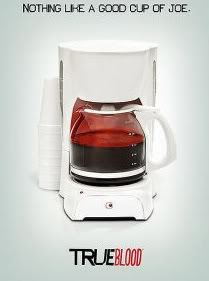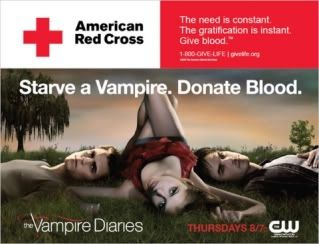You might look at the title and then this picture and go WHHHAAAT?! But really, I'm going to discuss something that everyone has and could be exceptionally important at times as well. BLOOD! After the last episode of True Blood
In the 1930's Takeji Furukawa set out to find a connection between personality traits being influenced by blood type. These days, approximately 90% of Japanese know their blood type and read their horoscopes by blood types rather than the traditional astrological signs! Blood typing has also been used for employers when interviewing and also in keeping office harmony, in matchmaking for potential love matches and even companies for marketing their products! Recently the books Eat Right 4 Your Type and Cook Right 4 Your Type have had many people wanting to make dietary changes that are directly related to their blood types! I highly recommend these books as I have found them to be very helpful with some of the problems related to dietary issues! BUT, we're here to talk about personalities! Now... if you don't know your blood type, the easiest way to find out is to donate blood! Not only will you be doing a VERY valuable service, but you will find your blood type out rather easily too! One thing to remember is there is no differential factor with the Rh type (positive/negative). So.. here we go with the blood types!
Type O:
Type O's tend to be loners OR leaders and are intuitive, focused, self-reliant and sometimes daring. They are initiators, although they don't always finish what they start! They handle stress better than the other blood types and have a healthy, active nature. Creative and popular, they love to be the center of attention and appear very self confident.
Positive qualities: Ambitious, Trendsetter, Independent, Loyal, Athletic, Robust, Passionate and Self-confident.
Negative qualities: Arrogant, Vain, Jealous, Insensitive and Ruthless.
Famous O's: Oprah Winfrey, Stella McCartney, Ronald Reagan, Queen Elizabeth II, John Lennon, Paul Newman, Elvis Presley, Gerald Ford, Mikhail Gorbachev, Al Capone.
Compatibility: O is most compatible with O, and AB
Type A:
While outwardly calm, they have high standards that they often bottle up their anxiety in order to get along with others, they may hold in their emotions until they explode. They are capable of leadership positions, but they may not take them because the stress is too much to handle. In Japan many A's are in research facilities taking roles in discovering more about science, economics, manufacturing, etc. They are perfectionists to say the least!! Type A's are also the most artistic of the blood groups.
Positive qualities: Reserved, Cooperative, Patient, Sensitive, Clever, Responsible and Punctual.
Negative qualities: Obsessive, Stubborn, Conservative and Tense.
Famous A's: George H. W. Bush, O.J. Simpson, Britney Spears, Ringo Starr, Adolf Hitler, Lyndon B. Johnson, Richard Nixon, Jet Li.
Compatibility: A is most compatible with A and AB
Type B:
Goal oriented and strong minded, type B's will start a task and see it through until completed, and completed well! Type B's are the individualists of the blood group categories and find their own way in life. These individuals tend to be balanced: thoughtful like A's, yet ambitious like O's. They are empathetic, easily understanding others' points of view, yet often hesitant to challenge or confront. Chameleon-like and flexible, they make good friends and are fiercely loyal.
Positive qualities: Creative, Passionate, Strong, Animal loving, Optimistic and Flexible.
Negative qualities: Wild, Unsociable, Critical, Indecisive, Unpredictable and Unforgiving.
Famous B's: Jack Nicholson, Luciano Pavarotti, Tom Selleck, Mia Farrow, Paul McCartney, Leonardo DiCaprio.
Compatibility: B is most compatible with B and AB
Type AB:
Type AB's are the split personalities of the blood groups! They can be both outgoing and shy, confident and timid, but they also tend to be very charming and popular. While responsible, too much responsibility will cause a problem. They don't sweat the small stuff, but once a problem hits they feel as though it is their own doing. Type AB's can be seen as spiritual and even at times a bit "flaky". They are trustworthy and like to help others. There is never a dull moment in a AB's life, so if you find one for a friend, consider yourself lucky! You'll definitely enjoy some exciting times together! Only about 2 - 5% of the population are blood type AB!
Positive qualities: Popular, Sociable, Cool and Controlled.
Negative qualities: Forgetful, Critical, Indecisive, Irresponsible and Self-centered.
Famous AB's: Barack Obama, John F. Kennedy, Marilyn Monroe, Mick Jagger, Thomas Edison, Jackie Chan.
Compatibility: AB is most compatible with AB, B, A and O, or basically everyone!!
PLEASE... if you can donate blood, DO IT!
Here is some brief information on blood donation from the American Red Cross website.-Facts about blood needs
* Every two seconds someone in the U.S. needs blood.
* More than 38,000 blood donations are needed every day.
* A total of 30 million blood components are transfused each year in the U.S. (2006).
* The average red blood cell transfusion is approximately 3 pints.
* The blood type most often requested by hospitals is Type O.
* The blood used in an emergency is already on the shelves before the event occurs.
* Sickle cell disease affects more than 80,000 people in the U.S., 98 percent of whom are African American. Sickle cell patients can require frequent blood transfusions throughout their lives.
* More than 1 million new people are diagnosed with cancer each year. Many of them will need blood, sometimes daily, during their chemotherapy treatment.
* A single car accident victim can require as many as 100 pints of blood.
-Facts about blood supply
* The number of blood donations collected in the U.S. in a year: 16 million (2006).
* The number of blood donors in the U.S. in a year: 9.5 million (2006).
* The number of patients who receive blood in the U.S. in a year: 5 million (2006).
* Share of the U.S. population eligible to give blood: Less than 38 percent.
* Blood cannot be manufactured – it can only come from generous donors.
* Type O-negative blood (red cells) can be transfused to patients of all blood types. It is always in great demand and often in short supply.
* Type AB-positive plasma can be transfused to patients of all other blood types. AB plasma is also usually in short supply.
-Facts about the blood donation process
* Donating blood is a safe process. A sterile needle is used only once for each donor and then discarded.
* Blood donation is a simple four-step process: registration, medical history and mini-physical, donation and refreshments.
* Every blood donor is given a mini-physical, checking the donor's temperature, blood pressure, pulse and hemoglobin to ensure it is safe for the donor to give blood.
* The actual blood donation typically takes less than 10-12 minutes. The entire process, from the time you arrive to the time you leave, takes about an hour and 15 min.
* The average adult has about 10 pints of blood in his body. Roughly 1 pint is given during a donation.
* A healthy donor may donate red blood cells every 56 days, or double red cells every 112 days.
* A healthy donor may donate platelets as few as 7 days apart, but a maximum of 24 times a year.
* All donated blood is tested for HIV, hepatitis B and C, syphilis and other infectious diseases before it can be released to hospitals.
* Information you give to the American Red Cross during the donation process is confidential. It may not be released without your permission except as directed by law.
-Facts about blood and its components
* There are four types of transfusable products that can be derived from blood: red cells, platelets, plasma and cryoprecipitate. Typically, two or three of these are produced from a pint of donated whole blood – hence each donation can help save up to three lives.
* Donors can give either whole blood or specific blood components only. The process of donating specific blood components – red cells, plasma or platelets – is called apheresis.
* One transfusion dose of platelets can be obtained through one apheresis donation of platelets or by combining the platelets derived from five whole blood donations.
* Most donated red blood cells must be used within 42 days of collection.
* Donated platelets must be used within five days of collection – new donations are constantly needed.
* Plasma and cryoprecipitate are stored in frozen state and can be used for up to one year after collection.
* Healthy bone marrow makes a constant supply of red cells, plasma and platelets. The body will replenish the elements given during a blood donation – some in a matter of hours and others in a matter of weeks.
-Facts about donors
* The number one reason donors say they give blood is because they "want to help others."
* Two most common reasons cited by people who don't give blood are: "Never thought about it" and "I don't like needles."
* One donation can help save the lives of up to three people.
* If you began donating blood at age 17 and donated every 56 days until you reached 76, you would have donated 48 gallons of blood, potentially helping save more than 1,000 lives!
* Half of Red Cross donors male, and half are female.
* The American Red Cross accepts blood donations only from volunteer donors.
* Among Red Cross donors in a given year, 19 percent donate occasionally, 31 percent are first-time donors, and 50 percent are regular, loyal donors.
* Only 7 percent of people in the U.S. have O-negative blood type. O-negative blood type donors are universal donors as their blood can be given to people of all blood types.
* Type O-negative blood is needed in emergencies before the patient's blood type is known and with newborns who need blood.
* Forty-five percent of people in the U.S. have Type O (positive or negative) blood. This percentage is higher among Hispanics – 57 percent, and among African Americans – 51 percent.
* Only 3 percent of people in the U.S. have AB-positive blood type. AB-positive type blood donors are universal donors of plasma, which is often used in emergencies, for newborns and for patients requiring massive transfusions.














0 comments:
Post a Comment